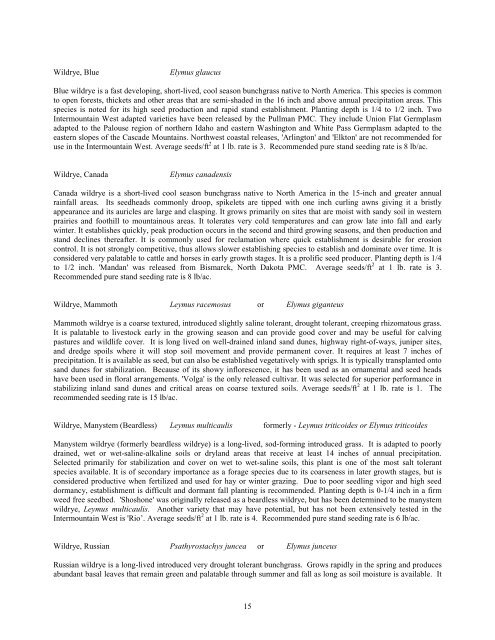Idaho Plant Materials Technical Note No. 24
Idaho Plant Materials Technical Note No. 24
Idaho Plant Materials Technical Note No. 24
You also want an ePaper? Increase the reach of your titles
YUMPU automatically turns print PDFs into web optimized ePapers that Google loves.
Wildrye, Blue<br />
Elymus glaucus<br />
Blue wildrye is a fast developing, short-lived, cool season bunchgrass native to <strong>No</strong>rth America. This species is common<br />
to open forests, thickets and other areas that are semi-shaded in the 16 inch and above annual precipitation areas. This<br />
species is noted for its high seed production and rapid stand establishment. <strong>Plant</strong>ing depth is 1/4 to 1/2 inch. Two<br />
Intermountain West adapted varieties have been released by the Pullman PMC. They include Union Flat Germplasm<br />
adapted to the Palouse region of northern <strong>Idaho</strong> and eastern Washington and White Pass Germplasm adapted to the<br />
eastern slopes of the Cascade Mountains. <strong>No</strong>rthwest coastal releases, 'Arlington' and 'Elkton' are not recommended for<br />
use in the Intermountain West. Average seeds/ft 2 at 1 lb. rate is 3. Recommended pure stand seeding rate is 8 lb/ac.<br />
Wildrye, Canada<br />
Elymus canadensis<br />
Canada wildrye is a short-lived cool season bunchgrass native to <strong>No</strong>rth America in the 15-inch and greater annual<br />
rainfall areas. Its seedheads commonly droop, spikelets are tipped with one inch curling awns giving it a bristly<br />
appearance and its auricles are large and clasping. It grows primarily on sites that are moist with sandy soil in western<br />
prairies and foothill to mountainous areas. It tolerates very cold temperatures and can grow late into fall and early<br />
winter. It establishes quickly, peak production occurs in the second and third growing seasons, and then production and<br />
stand declines thereafter. It is commonly used for reclamation where quick establishment is desirable for erosion<br />
control. It is not strongly competitive, thus allows slower establishing species to establish and dominate over time. It is<br />
considered very palatable to cattle and horses in early growth stages. It is a prolific seed producer. <strong>Plant</strong>ing depth is 1/4<br />
to 1/2 inch. 'Mandan' was released from Bismarck, <strong>No</strong>rth Dakota PMC. Average seeds/ft 2 at 1 lb. rate is 3.<br />
Recommended pure stand seeding rate is 8 lb/ac.<br />
Wildrye, Mammoth Leymus racemosus or Elymus giganteus<br />
Mammoth wildrye is a coarse textured, introduced slightly saline tolerant, drought tolerant, creeping rhizomatous grass.<br />
It is palatable to livestock early in the growing season and can provide good cover and may be useful for calving<br />
pastures and wildlife cover. It is long lived on well-drained inland sand dunes, highway right-of-ways, juniper sites,<br />
and dredge spoils where it will stop soil movement and provide permanent cover. It requires at least 7 inches of<br />
precipitation. It is available as seed, but can also be established vegetatively with sprigs. It is typically transplanted onto<br />
sand dunes for stabilization. Because of its showy inflorescence, it has been used as an ornamental and seed heads<br />
have been used in floral arrangements. 'Volga' is the only released cultivar. It was selected for superior performance in<br />
stabilizing inland sand dunes and critical areas on coarse textured soils. Average seeds/ft 2 at 1 lb. rate is 1. The<br />
recommended seeding rate is 15 lb/ac.<br />
Wildrye, Manystem (Beardless) Leymus multicaulis formerly - Leymus triticoides or Elymus triticoides<br />
Manystem wildrye (formerly beardless wildrye) is a long-lived, sod-forming introduced grass. It is adapted to poorly<br />
drained, wet or wet-saline-alkaline soils or dryland areas that receive at least 14 inches of annual precipitation.<br />
Selected primarily for stabilization and cover on wet to wet-saline soils, this plant is one of the most salt tolerant<br />
species available. It is of secondary importance as a forage species due to its coarseness in later growth stages, but is<br />
considered productive when fertilized and used for hay or winter grazing. Due to poor seedling vigor and high seed<br />
dormancy, establishment is difficult and dormant fall planting is recommended. <strong>Plant</strong>ing depth is 0-1/4 inch in a firm<br />
weed free seedbed. 'Shoshone' was originally released as a beardless wildrye, but has been determined to be manystem<br />
wildrye, Leymus multicaulis. Another variety that may have potential, but has not been extensively tested in the<br />
Intermountain West is 'Rio’. Average seeds/ft 2 at 1 lb. rate is 4. Recommended pure stand seeding rate is 6 lb/ac.<br />
Wildrye, Russian Psathyrostachys juncea or Elymus junceus<br />
Russian wildrye is a long-lived introduced very drought tolerant bunchgrass. Grows rapidly in the spring and produces<br />
abundant basal leaves that remain green and palatable through summer and fall as long as soil moisture is available. It<br />
15
















